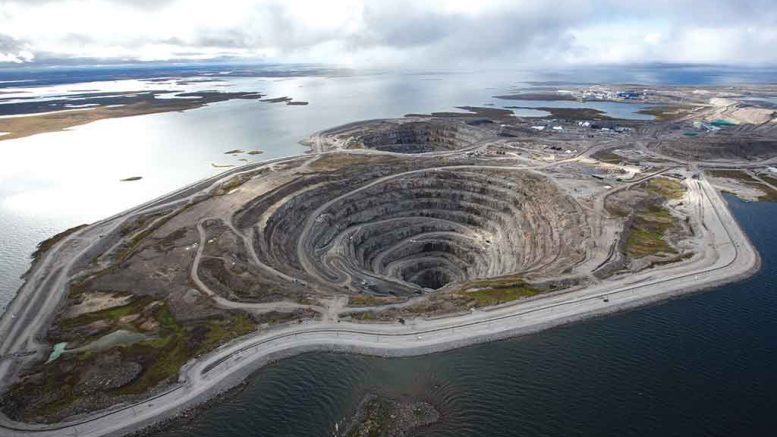The planned closure of three producing diamond mines in the Northwest Territories in the next few years will open a gap in the territorial economy, but the N.W.T.’s industry minister says she’s confident several ongoing initiatives could fill the economic hole.
The Ekati mine, operated by Arctic Canadian Diamond, is expected to close as soon as 2024. Rio Tinto (NYSE: RIO; LSE: RIO; ASX: RIO)’s Diavik mine, located 30 km southeast of Ekati, is due to close in 2025. And De Beers’ Gahcho Kué mine is slated to run until 2028.
The mines — which are hundreds of kilometres northeast of Yellowknife and accessible only by winter road — comprise more than 29% of the territorial GDP, according to a joint report issued by De Beers and Rio Tinto in January.

The Kennady North project is located 300 km east-northeast of Yellowknife, NWT. Credit: Mountain Province Diamonds
Diavik alone employs more than 1,000 workers and contractors, a workforce that wouldn’t be matched even if the Nechalacho, NICO, Prairie Creek and Pine Point projects become fully producing mines, the NWT and Nunavut Chamber of Mines noted in April.
But Caroline Wawzonek, Minister of Industry, Tourism and Investment told The Northern Miner in an interview at the Prospectors and Developers Association of Canada (PDAC) conference in Toronto on Tuesday that the territorial government is looking to diversify the economy and grow the mineral resources industry.
“That’s foundationally what needs to happen,” she said.
Diamond exploration
On the diamonds front, Wawzonek said there is “good news” from exploration work in the region of the existing mines.
“[With] exploration happening around Gahcho Kué with Mountain Province Diamonds’ Kennedy [North] Project [and] Arctic Star. They are finding kimberlites, they’re out exploring,” she said.
Arctic Star Exploration (TSXV: ADD), which holds in partnership with Margaret Lake Diamonds (TSXV: DIA) the Diagras property southeast of Diavik, in the Lac de Gras kimberlite field, announced the discovery of a new kimberlite at the project in June.
The Arbutus kimberlite appears to be about 200 metres long and 25 metres wide. Out of nine holes and 1,098 metres completed in Arctic Star’s spring 2022 drill program, six were aimed at further delineating the previously discovered Sequioa kimberlite complex and three drilled new targets.
A total of 504 metres of kimberlite was intersected at Sequoia (with the longest intercept measuring 207 metres starting at 18 metres depth). A total of 41.4 metres was intercepted in two holes (each starting at 8 metres depth) at Arbutus.
Mountain Province Diamonds (TSX: MPVD; OTC: MPVD), which holds a 49% interest in Gahcho Kué and 100% of Kennady North, announced highlights from its winter drill program at Kennady in May. The company reported that hypabyssal kimberlite and volcaniclastic kimberlite has been intersected in 16 of 20 drill holes at three sites. Summer exploration at Kennady North is scheduled to start in the third quarter.
Wawzonek also said that if positive results continue to come back from exploration work, “there’s not an unreasonable chance that there could see an extension” of some diamond mines.
Arctic Canadian Diamond, for its part, has indicated that possibility and in February announced that it had awarded a contract to IHC Mining to build an underwater remote mining (URM) system to extract diamond-bearing kimberlite from deep open pits at Ekati.
The system comprises a floating platform, an underwater mining crawler device and a land-based dewatering plant.
The URM project could allow Ekati to extend the mine life by at least 10 years, Arctic said, with the system reducing the mine’s environmental footprint by generating minimal waste.
It is due to be tested this summer at Ekati’s mined-out Lynx open pit, followed by more testing in the summers of 2023 and 2024, including a trial mining launch targeting about 150,000 tonnes of kimberlite ore.
Good as gold
Wawzonek also touched on the potential for gold — the traditional mainstay of mining in the Yellowknife area — to contribute economically after diamond mining winds down.
“With all the focus on critical minerals and metals, folks aren’t talking about that,” she said. “But there’s a lot of gold work happening back in the North, both on the projects that were in existence previously, but also in new areas. I’ve heard a lot of excitement on that in the last few months.”
Speaking generally, the industry minister referred to gold exploration projects around Yellowknife and in the Tlicho lands area, north and northeast of the city.
She specifically cited Nighthawk Gold (TSX: NHK; US-OTC: MIMZF), which holds a property of more than 930 sq. km within the Indin Lake Greenstone Belt, about 200 km north of Yellowknife.
The Colomac Main deposit, a historic open pit gold mine on the property that produced 527,908 oz. Gold, was acquired by Nighthawk in 2012.
In March, the company reported an updated resource estimate that increased open pit indicated resources by 121% to 2.1 million oz. of gold in 46.4 million tonnes averaging 1.38 grams gold per tonne. The open pit inferred resource rose by 1,400% to 601,000 oz. gold in 7.8 million tonnes grading 2.39 grams gold.
Nighthawk began the first phase of a two-year, 100,000-metre drilling program in May that will include expansion drilling at the Colomac Centre and Kim and Cass deposits.


Be the first to comment on "PDAC 2022: Promising diamond, gold exploration might fill economic void after diamond mines close, says NWT industry minister"